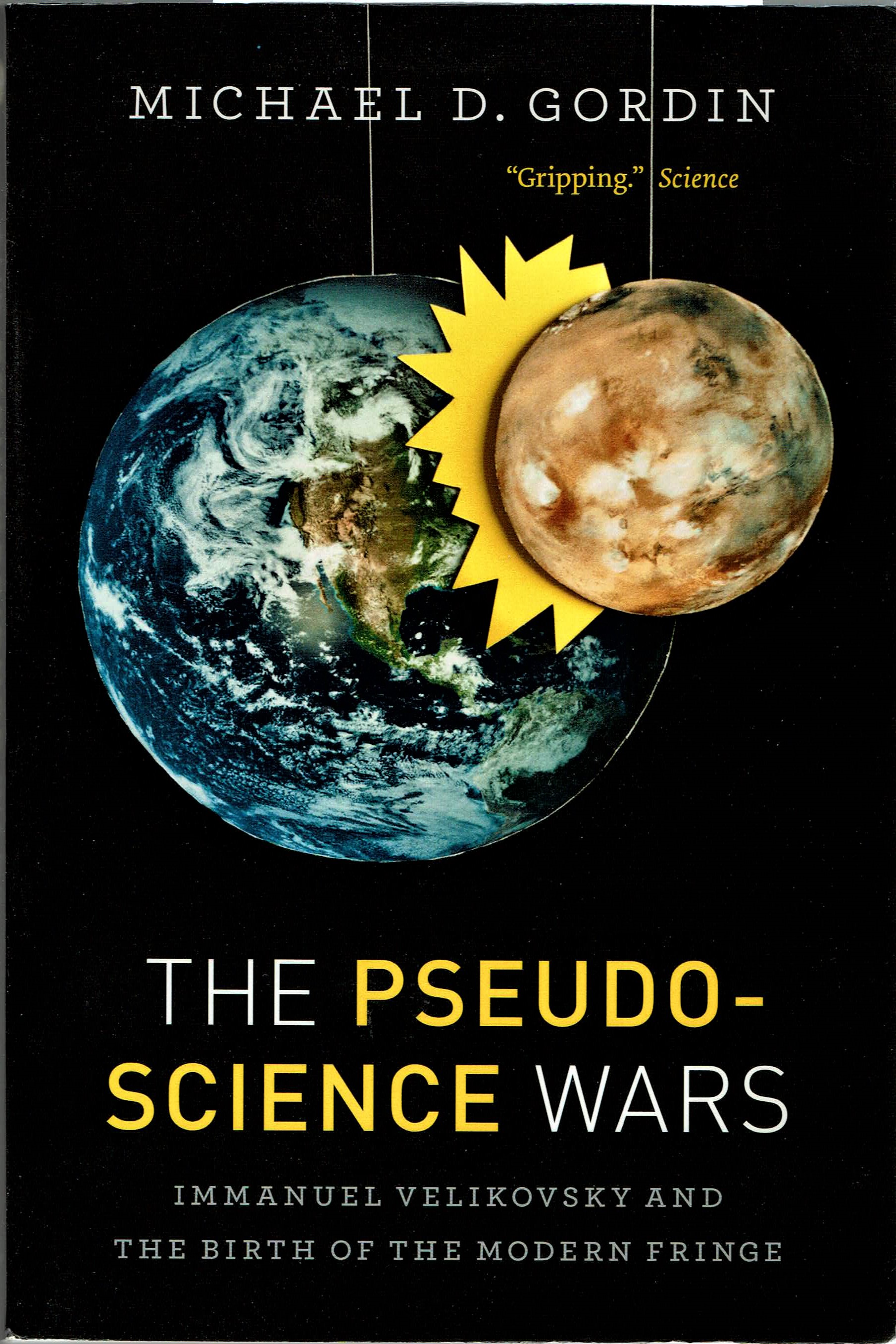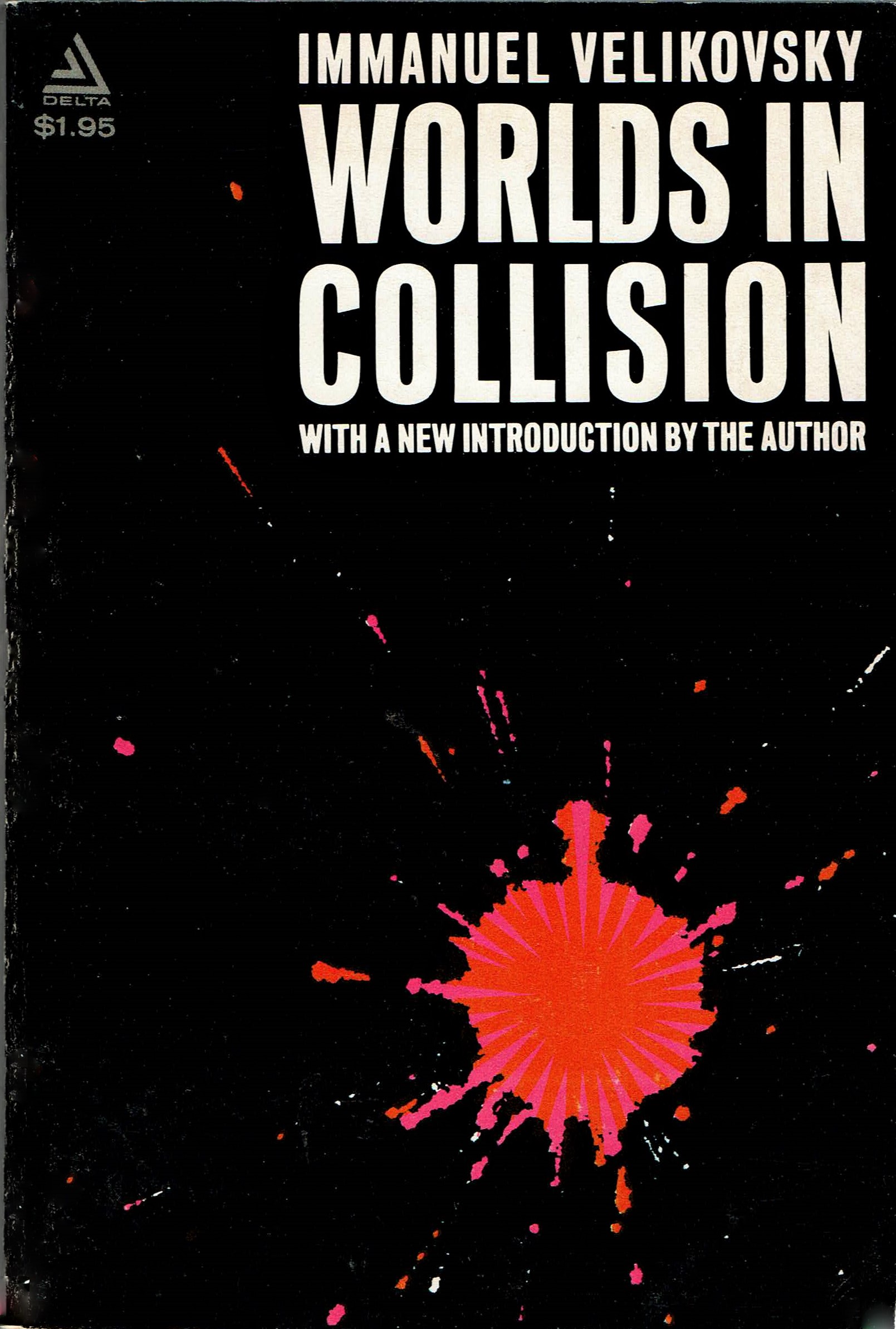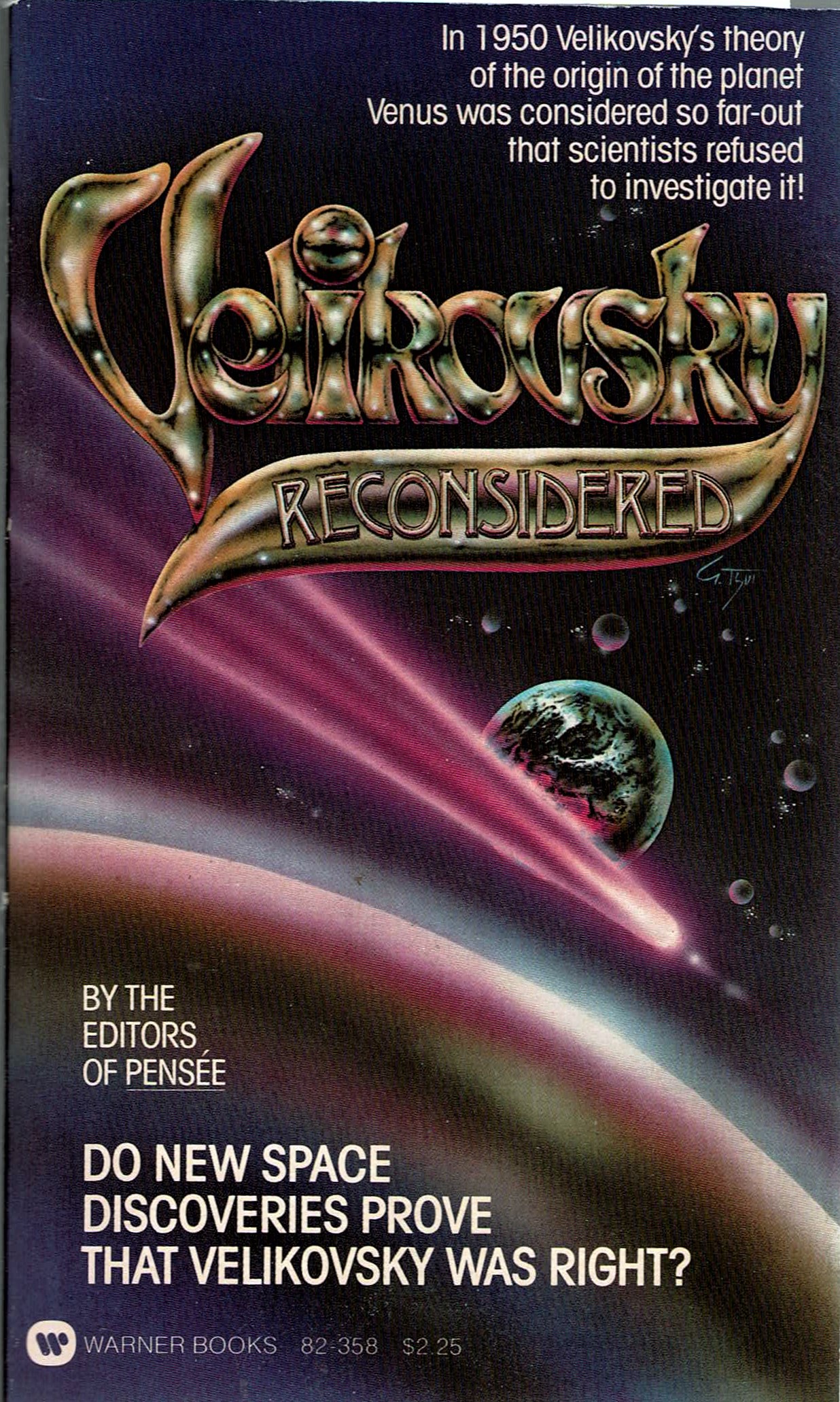Grove Koger

This piece about controversial writer Immanuel Velikovsky (born June 10, 1895) originally appeared in the now-defunct Philadelphia Review of Books on June 9, 2014.
□□□
September 1965 found me newly enrolled in a small college in Southwestern Idaho where I had been assigned, for reasons that I’ve never grasped, a room in what was popularly known as my dorm’s “Animal Wing.” There I was, thirsty for sophistication and armed with a hundred or so books and classical LPs, forced to live with a pack of jocks!
Well, the jocks weren’t happy either, and didn’t take kindly to this modest intrusion of culture. One weekend while I was away, they broke into my room, threw my books in a heap on the floor, and covered them with shaving cream. The dorm director—a biology professor by day—made sympathetic noises about the damage, but his greatest concern seemed to be directed at one of the books on the floor. Most of the book’s cover was visible, and as the fellow nudged it gingerly out of the pile with his foot, he said, “You really shouldn’t be reading that.”
That was a trade paperback reprint of Immanuel Velikovsky’s 1950 bestseller Worlds in Collision, and at the time I’d scarcely glanced at it. But thanks to the biology professor, I realized immediately just how much academics hated Immanuel Velikovsky, and decided just as immediately to start reading this book that I wasn’t supposed to be reading.
□□□
As I soon discovered, Velikovsky’s thesis in Worlds in Collision was that the planet Venus had been ejected as a comet from the much larger planet Jupiter and had almost collided with the Earth, resulting in the terrifying “plagues” recounted in Exodus. Mars was pulled out of its orbit by the violent interaction, and several centuries later it too nearly collided with the Earth, leading to the events described in Isaiah and rendered poetically as the conflict between Athena and Ares in The Iliad.
How did Velikovsky arrive at such a doozy of a story? As Princeton University history professor Michael Gordin makes clear in The Pseudo-Science Wars: Immanuel Velikovsky and the Birth of the Modern Fringe, the publication of Worlds in Collision was the culmination of a long and circuitous series of events in its author’s life. Born into a wealthy Jewish family in Russia in 1895, Velikovsky studied in Edinburgh before graduating with a degree in medicine from Moscow University. He moved with his parents to Germany in 1921, then on to Palestine a few years later. An ardent Zionist and budding scholar, he contributed to a series of learned publications intended to lay the groundwork for a university to be founded in Jerusalem.
By 1928 Velikovsky’s interests had turned to psychoanalysis, leading him to study for a time under Wilhelm Stekel, one of Sigmund Freud’s pupils. However, Velikovsky was incensed by Freud’s last work, the controversial Moses and Monotheism of 1937,which argued that Moses had actually been an Egyptian priest (!) who was assassinated by his Hebrew followers (!!) after the Exodus. Determined to refute the master’s book, which he viewed as an attack on Judaism itself, Velikovsky traveled with his wife and two daughters to New York City in 1939 to consult works in the city’s many research libraries.
Velikovsky intended to show that Freud was deeply conflicted over his own Jewish identity and that Moses and Monotheism was a product of his torment. However, in the midst of his research—which involved Moses as well as Freud—Velikovsky chanced upon a reference that suggested to him that many of the events described in Exodus were in fact the result of an enormous natural catastrophe. He discovered an account by one Ipuwer, an Egyptian sage, that seemed to describe the same catastrophic events. Broadening his research, Velikovsky found what seemed to be parallels in folklore and mythology from around the world, and he began to suspect that Venus was involved …

Pre-publication summaries of Worlds in Collision in several popular magazines, including Harper’s, alerted professional scientists as well as the general public to the book’s revolutionary thesis. Believing that Velikovsky’s reconstruction of the recent history of the solar system was absurd, a number of the former contacted the book’s publisher, Macmillan, with expressions of dismay and threats of a boycott. One astronomer wrote, “There is a strong sentiment among many individuals to ‘black-list’ you in the selection of books for class use, and also in the choice of a publisher for new books.” Macmillan could deal with the dismay, but since the firm derived most of its income from the sale of scientific textbooks to colleges and universities, it was forced to take the threats seriously. Determining that its contract with Velikovsky allowed it to transfer the book to another publisher so long as the author suffered no financial loss, it turned over Worlds in Collision to Doubleday and its staff breathed a collective sigh of relief.
Doubleday got free publicity and a runaway best-seller out of the deal, and over the following years, during which the controversy surrounding Velikovsky waxed and waned, published six more of his works. These included Ages in Chaos (1952), in which he posited a revised chronology for the ancient Near East intended to buttress his claims, and Earth in Upheaval (1955), in which he presented geological evidence for the catastrophes he had described in Worlds in Collision. For their part, professional scientists were satisfied that the problem had gone away.
And for his part, Velikovsky readily assumed the mantle of a heretic, a 20th-century Galileo whose censors and critics refused to peer through the telescope that he was offering them.
□□□
Although Gordin spends several pages trying to define pseudoscience, he concludes that it’s impossible to do so satisfactorily. Instead, after recounting the early years of the Velikovsky controversy, he opts to compare Velikovskyism to several other fringe belief systems and to analyze them historically. These have little or no similarity in terms of content, but studying how they develop and how their principals seek mainstream legitimacy while maintaining order within their own ranks does tell us a lot about the nature of pseudoscience in general and Velikovsky’s version in particular.
Gordin begins this section by asking why, exactly, scientists “lashed out” with “such rage” at Macmillan. Velikovsky himself theorized that the horrendous cataclysms he described had resulted in a kind of collective amnesia in mankind, one that generated a violent reaction when disturbed. But Gordin finds the answer in American scientists’ awareness of another, somewhat contemporaneous pseudoscience, Lysenkoism, from the other side of the world.
Trofim Denisovich Lysenko was a Russian agronomist who developed a “Marxist” approach to heredity, arguing that he could alter seeds in such a way that the changes would be passed on to succeeding generations. So influential did Lysenko become in Stalinist Russia that he managed to take over the Academy of Agricultural Sciences, with disastrous results for Soviet agriculture and deadly consequences for the legitimate geneticists who had dared oppose him. This Soviet misadventure may not have made much of an impression on the American public, but American scientists were well aware of the plight of their Soviet counterparts, and seem to have viewed Velikovsky as an American Lysenko in the making.
Gordin also examines Velikovskyism alongside eugenics. Here he points out that both Velikovsky and Frederick Osborn, a leader of the American eugenics movement, made attempts to cultivate allies within the scientific community with an aim to establishing respectability. In the case of Velikovsky, this included a successful approach to Princeton University geology professor Harry Hess, whom he contacted while writing Earth in Upheaval. (Velikovsky had moved to the New Jersey borough of Princeton in 1952.) Hess praised Velikovsky for rising above “the prejudices and … taboos which confine the thinking of most of us,” and remained a sympathizer for the rest of his life.
A more important figure, however, was fellow Princeton resident Albert Einstein, who objected to the way Velikovsky had been treated by the scientific community and came to enjoy his company. However, he could not accept the central tenet of Velikovsky’s thesis, summing up his reaction as “catastrophes yes, Venus no.” To a Princeton colleague, Einstein would confide that he viewed Velikovsky as “gifted, but crazy”—a verdict that I suspect Gordin subscribes to.
Velikovsky managed a few genuine successes in this vein, including one involving Columbia University astronomer Lloyd Motz and Princeton University mathematician Valentine Bargmann, who wrote what Gordin calls an “extraordinary” letter in 1962 to Science, the highly respected publication of the American Association for the Advancement of Science (AAAS). Although they made it clear that they disagreed with Velikovsky’s theories, they pointed out that two recent discoveries about the planets—that Venus has a high temperature and that Jupiter emits radio noises—had been predicted by Velikovsky.
□□□
Interest in Velikovsky was reawakened in the 1960s thanks to the efforts of several new supporters, including Alfred De Grazia. A professor of government and social theory at New York University and founder of the journal American Behavioral Scientist, De Grazia devoted the September 1963 issue of the journal to Velikovsky, his ideas, and how those ideas had been received by professional scientists. A “scathing” review in the Bulletin of the Atomic Scientists generated such good publicity that De Grazia republished the issue in 1966 as The Velikovsky Affair. This new version included additional material by other supporters as well as the text of the offending review.

By the time my dorm director tried to set me straight in 1965, the Velikovsky affair was again in full swing. Revolution was in the air, and Velikovsky had become a favorite with disaffected college and university students, of whom there was then no shortage. He lectured on an astonishing 60 campuses between 1964 and 1969, including Yale and Harvard, and in the early years of the following decade was invited to speak at two NASA divisions, including the Langley Research Center. In 1972 Pensée, a publication of the Student Academic Freedom Forum of Portland’s Lewis and Clark College, began a series called “Immanuel Velikovsky Reconsidered.” (Selections were subsequently published in book form as Velikovsky Reconsidered.) The series, which I subscribed to and read avidly, ran for two and a half years and reached an annual circulation of as much as twenty thousand before Velikovsky, in effect, destroyed it by attempting to control it. However, several other pro-Velikovsky journals sprang up in its place.
A climax of sorts was reached with a symposium sponsored by the AAAS in San Francisco in 1974, one of four Velikovsky symposia held that year. The meeting drew an audience of close to fifteen hundred and ran for seven hours. Velikovsky’s primary opponent was eloquent astronomer Carl Sagan, but Velikovsky, who at 79 was twice Sagan’s age, seems to have given as good as he got. Predictably enough, each side declared victory.
Velikovsky continued to attract acolytes and followers until his death in 1979, but many had ideas of their own, ideas that owed something to Velikovsky but that spiraled off into even stranger realms. What few survive do so almost entirely on the World Wide Web.
□□□
The Pseudo-Science Wars is not, of course, the kind of book that Velikovsky hoped would be written about him. He had envisioned much grander treatment, and looked forward to the establishment of archives at widely scattered locations around the globe, research centers in which future historians of science could study his ideas and his struggle. Yet Gordin is a fair and objective chronicler, and even seems to feel a certain admiration for this man he never met. (He actually lives a block away from the house in Princeton that was once Velikovsky’s.)
As Gordin makes clear, Velikovsky’s thesis was an exciting one. He admits that Worlds in Collision is an “enthralling read” and that Earth in Upheaval is “no less riveting.” To borrow a term from today’s facile political punditry, Velikovsky’s “narratives”—the scenarios he presented in his books and the controversy he found himself involved in—were powerful and attractive.
However, another factor working in his favor was the scientific ignorance of the general public, a situation that many of his followers came to realize. Are things any better now?
It will come as news to no one that denial of global warming is widespread in the United States. A recent survey conducted for Yale and George Mason universities has found that the number of Americans who do not believe that global warming is occurring has increased by 7 percentage points to 23 percent. [My words were written in 2014; since then, the situation has surely grown worse.] Only half or so of our fellow citizens seem to be worried about the world’s climate, and only 15 percent are “very worried.” If you choose, consciously or unconsciously, to be a denialist, there are plenty of publications, television “news” sources, and online sites ready to assure you that you’re right—and to tell you where to send your money.
In retrospect it seems clear that Velikovsky posed no threat to American scientists in the 1950s. But today’s pseudoscience of global warming denial enjoys a privileged status, drawing seemingly endless funding from the extractive industries while cozying up to one of our major political parties. It may well lie on the fringe of accepted science, but it has taken a position near the center of our political stage, and the danger it poses isn’t so much to scientists as to all of us. Ideas, like acts, have always had consequences, but in circumstances such as today’s, those consequences can be dire.
Keep up the good work!!!!
LikeLike
Working on it. Thanks!
LikeLike
Velikovsky Predicted Venus would be very hot.
Got no credit.
Velikovsky predicted radio signals from Jupiter
Got no credit.
People like to find one thing he got wrong, then discredit his whole body of work.
Copernicus had a lot of wacky ideas, and one really good one.
Velikovsky changed my life for the better.
LikeLike